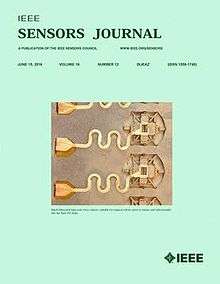IEEE Sensors Journal
 | |
| Discipline | Sensors |
|---|---|
| Language | English |
| Edited by | Sandro Carrara |
| Publication details | |
Publication history | 2001–present |
| Publisher | |
| Frequency | Biweekly |
| 2.512 | |
| Standard abbreviations | |
| IEEE Sens. J. | |
| Indexing | |
| CODEN | ISJEAZ |
| ISSN |
1530-437X |
| LCCN | 00214867 |
| OCLC no. | 44160724 |
| Links | |
The IEEE Sensors Journal is a biweekly peer-reviewed scientific journal, covering research on sensors. It is published by the IEEE Sensors Council. The editor-in-chief is Sandro Carrara. According to the Journal Citation Reports, the journal has a 2016 impact factor of 2.512.[1]
Editorial keywords for manuscript classification
The Keywords are used to assign a manuscript to a Topical Area of the Journal (see Editorial Board Structure below)
| Keyword | Research Areas Covered |
|---|---|
| SYST | Sensor system integration
|
| NETW | Sensor system networks
|
| PHEN | Sensor Phenomenology
|
| MODL | Sensor modelling
|
| SIEL | Sensor Interface Electronics
|
| DATP | Sensor Data Processing
|
| APPL | Sensor Applications
|
| ACTU | Sensor-Actuators
|
| MATR | Sensor Materials
|
| MECH | Mechanical Sensors
|
| MASS | Mass-Sensitive Sensors
|
| THER | Thermal Sensors
|
| MAGN | Magnetic Sensors
|
| OPTO | Optoelectronic and Photonic Sensors
|
| MICR | THz/Microwave/Millimeter Wave Sensors |
| IONI | Ionizing Radiation Sensors (such as gamma ray, X-ray, charged particle and neutron detectors) |
| FIBR | Fiber-Optic Sensors
|
| INTO | Integrated Optics Sensors |
| CHEM | Chemical and Biological Sensors
|
Editorial Board structure
The Editorial Board is structured in 10 Topical Areas, each led by a Topical Editor. A Topical Area encompasses a group of 'core' Associate Editors with main expertise in that Topical Area. Topical Areas also have a 'pool' membership of Associate Editors from other Topical Areas, with interdisciplinary expertise. Each Associate Editor is a core member of a single Topical Area, but can be a pool member of several other Topical Areas.

Journal leadership
| Editor-in-Chief | Start Date | End date |
|---|---|---|
| Vladimir Lumelsky, University of Wisconsin Madison, USA | 2001 | 2003 |
| H Troy Nagle, North Carolina State University, USA | 2004 | 2009 |
| Evgeny Katz, Clarkson University, USA | 2009 | 2011 |
| Krikor B Ozanyan, The University of Manchester, U.K. | 2012 | 2018 |
| Sandro Carrara, EPFL, Lausanne, Switzerland | 2018 | present |
Best paper awards
The annual IEEE Sensors Journal Best Paper Award recognizes the best paper published in the journal. Winners are presented with a certificate and $2,000 split equally among the authors.[2]
Historical data: published papers and downloads

References
- ↑ "IEEE Sensors Journal". 2016 Journal Citation Reports. Web of Science (Science ed.). Clarivate Analytics. 2017.
- ↑ "Awards". IEEE Sensors Council. Retrieved 2017-06-18.